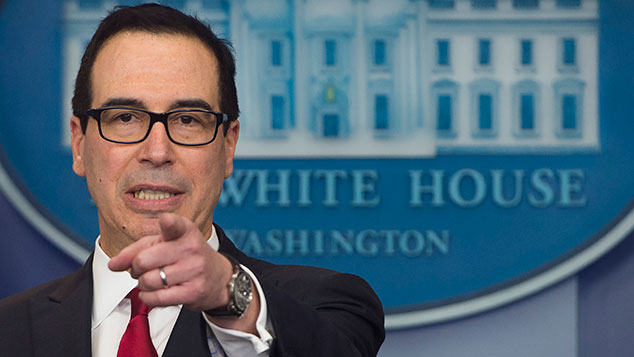
Who’d be a currency trader?
I mean, you sit there in front of your computer, getting all your charts lined up in a row.
(You’ve learned enough by now to avoid paying too much attention to the fundamentals – they might matter in the long term, but that’s way too far away for currency trading.)
You’ve got a nice trend going on. You’re feeling pretty chirpy. Your account is in the black, your risk is nicely managed, it’s all good.
Five minutes later, Donald Trump opens his mouth, and all your profits are gone…
Slapstick and panic in the foreign exchange markets
Earlier this week – Wednesday, in fact – the US Treasury secretary Steve Mnuchin gave the dollar (already on the slide) a good hard shove on the downhill slope.
As I discussed yesterday, a good hard shove on the downhill slope. Usually they just pretend they want a strong dollar and leave it at that.
To be fair, there’s a reason for that. These days, we try to avoid old-fashioned protectionism. Most people are onboard with the idea that in theory, trade should be as free as possible and that this is for the common good. So naked protectionism is typically frowned upon and there are rules against it.
But as everyone also knows, you can do protectionism by the back door via the mechanism of currency wars. Currencies are largely free-floating these days, which is another form of market discipline that most nations – in theory – have bought into.
Broadly speaking, your economic policies will help to dictate the value the market ascribes to your currency and will also guide the direction of capital flows around the globe.
However, if you weaken your currency artificially, then you can make your exports more competitive without too many immediate headaches. It’s one reason why Germany has done so well out of the euro – by hitching itself to the likes of Greece, the euro remains much weaker than the Deutschmark would ever have been.
No one wants an all-out currency war to break out because these things can get bad-tempered very quickly. So everyone talks around the subject and central banks often co-ordinate their policies to avoid any diplomatic incidents.
For example, Japan’s big push to weaken the yen back in 2012 was clearly deemed acceptable at the time because the country had been carrying the burden of “strongest global currency” for too long.
So politicians are meant to keep their beaks out of this stuff. They’re not supposed to have an official currency policy or target exchange rate. To suggest that they do risks causing no end of tit-for-tat manoeuvring.
Hence the controversy around Mnuchin’s otherwise rather mundane statement of the blindingly obvious. (You start to understand why it’s so difficult for politicians to speak as plainly as they might like to.)
Indeed, European Central Bank (ECB) boss Mario Draghi even brought up the topic in his press conference after the bank’s latest rate-setting meeting. He warned that shifts in the exchange rate were partly down to “the use of language… that doesn’t reflect the terms of reference we have agreed”.
Anyway – yesterday, Mnuchin’s boss, Donald Trump, waded into the conversation. As the dollar was merrily plunging, Trump said that Mnuchin’s comments had been taken out of context. Indeed, “the dollar is going to get stronger and stronger and ultimately I want to see a strong dollar”.
The US currency spiked, naturally, upending all those traders who had taken Mnuchin at his word.
The dollar is weak because global investors are bullish
Anyway, for all that it was a bit of a slapstick moment, the US currency is still back on the downward path this morning (adding insult to the injury of all those traders already kicked out of the market).
So why is the dollar so weak in the first place? There is a general sense of bafflement at this, but I’m not sure it’s as hard to explain as many commentators seem to believe.
At face value, it does seem odd. The US economy is doing well. The Federal Reserve is further ahead with tightening monetary policy than any other central bank. US bond yields are higher than yields in other currency areas.
All else being equal, you’d think that would add up to a stronger dollar.
But all else is never equal in markets.
Firstly, everyone has viewed the US as the “cleanest shirt” and the “safest bet” for many many years now. That view is in the process of being unwound gradually. Europe and Japan both offer fresh opportunity – a promise of change for the better – whereas the US is only as good as it was already considered to be.
In a world of relative performance, that means more money is going to be interested in heading back to Europe and Japan rather than hanging around in the safety of the US.
In effect, a weakening dollar is a sign that the world is bullish. When things look doubtful, the US is one of the ultimate safe haven assets. The US dollar is the world’s reserve currency, and when the world is fearful, the reserve currency stays at home. When the world is bullish, on the other hand, the reserve currency sets sail from familiar shores to seek its fortune elsewhere.
I realise that sounds very simplistic compared to sitting there calculating yield differentials and breakevens and purchasing power parities and all the rest of it – but at the end of the day, that’s what it boils down to. A weaker dollar generally reflects a global growth mindset, and a stronger one reflects a contractionary mindset. It’s not always that simple but it’s a good rule of thumb.
And unless you’re a forex trader (which I very much advise against), you don’t really need to sweat the details of the currency markets much beyond that.